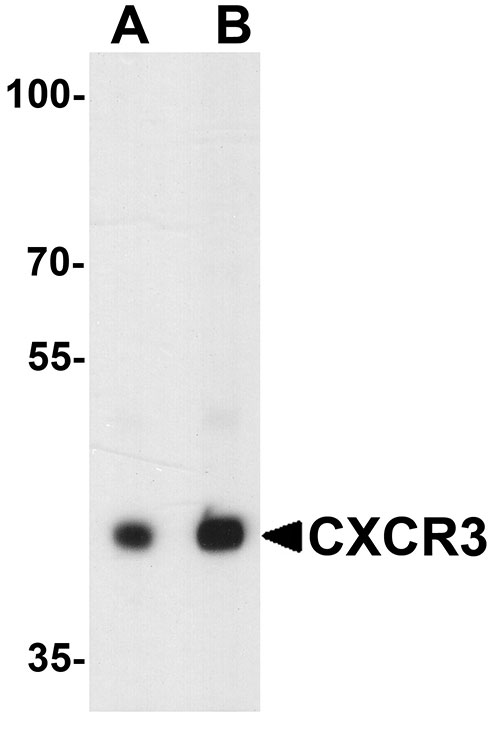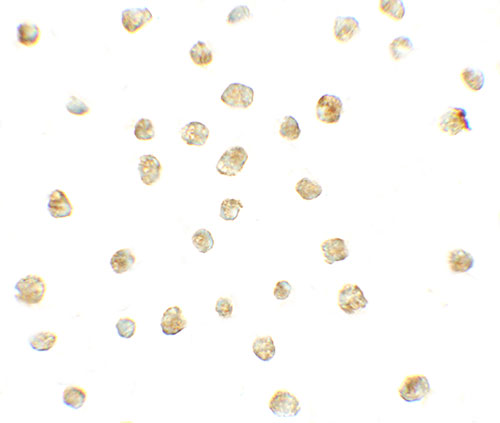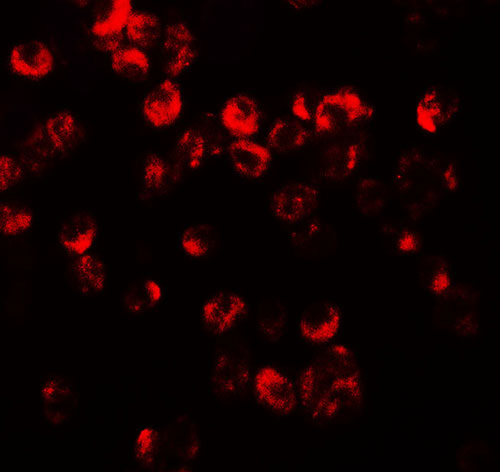CXCR3 Antibody
- 产品详情
- 实验流程
- 背景知识
Application
| WB, IF, ICC, E |
|---|---|
| Primary Accession | P49682 |
| Other Accession | NP_001136269, 218563730 |
| Reactivity | Human, Mouse, Rat |
| Host | Rabbit |
| Clonality | Polyclonal |
| Isotype | IgG |
| Calculated MW | 40660 Da |
| Concentration (mg/ml) | 1 mg/mL |
| Conjugate | Unconjugated |
| Application Notes | CXCR3 antibody can be used for detection of CXCR3 by Western blot at 1 - 2 µg/ml. Antibody can also be used for Immunocytochemistry at 5 µg/mL. For Immunoflorescence start at 20 µg/mL. |
| Gene ID | 2833 |
|---|---|
| Other Names | C-X-C chemokine receptor type 3, CXC-R3, CXCR-3, CKR-L2, G protein-coupled receptor 9, Interferon-inducible protein 10 receptor, IP-10 receptor, CD183, CXCR3, GPR9 |
| Target/Specificity | CXCR3; CXCR3 antibody is human, mouse and rat reactive. At least two isoforms of CXCR3 are known to exist; this antibody will detect both isoforms. |
| Reconstitution & Storage | CXCR3 antibody can be stored at 4℃ for three months and -20℃, stable for up to one year. |
| Precautions | CXCR3 Antibody is for research use only and not for use in diagnostic or therapeutic procedures. |
| Name | CXCR3 |
|---|---|
| Synonyms | GPR9 |
| Function | [Isoform 1]: Receptor for the C-X-C chemokine CXCL9, CXCL10 and CXCL11 and mediates the proliferation, survival and angiogenic activity of human mesangial cells (HMC) through a heterotrimeric G- protein signaling pathway (PubMed:12782716). Binds to CCL21. Probably promotes cell chemotaxis response. Upon activation by PF4, induces activated T-lymphocytes migration mediated via downstream Ras/extracellular signal-regulated kinase (ERK) signaling. [Isoform 3]: Mediates the activity of CXCL11. |
| Cellular Location | [Isoform 1]: Cell membrane; Multi-pass membrane protein |
| Tissue Location | Isoform 1 and isoform 2 are mainly expressed in heart, kidney, liver and skeletal muscle. Isoform 1 is also expressed in placenta. Isoform 2 is expressed in endothelial cells. Expressed in T-cells (at protein level). |
For Research Use Only. Not For Use In Diagnostic Procedures.
Provided below are standard protocols that you may find useful for product applications.
BACKGROUND
The CXCR3 protein is a G protein-coupled receptor with selectivity for three chemokines, termed CXCL9/Mig (monokine induced by interferon-gamma), CXCL10/IP10 (interferon-gamma-inducible 10 kDa protein) and CXCL11/I-TAC (interferon-inducible T cell alpha-chemoattractant) (reviewed in 1). Binding of chemokines to this protein induces cellular responses that are involved in leukocyte traffic, most notably integrin activation, cytoskeletal changes and chemotactic migration (2). Similar to other chemokine receptors such as CXCR4, CXCR3 has been implicated in several malignancies as a biomarker of tumor behavior as well as a potential therapeutic target (3).
REFERENCES
Groom JR and Luster AD. CXCR3 ligands: redundant, collaborative and antagonistic functions. Immunol. Cell Biol. 2011; 89:207-15.
Maghazachi AA. Role of chemokines in the biology of natural killer cells. Curr. Top Microbiol. Immunol. 2010; 341:37-58.
Fulton AM. The chemokine receptors CXCR4 and CXCR3 in cancer. Curr. Oncol. Rep. 2009; 11:125-31.
终于等到您。ABCEPTA(百远生物)抗体产品。
点击下方“我要评价 ”按钮提交您的反馈信息,您的反馈和评价是我们最宝贵的财富之一,
我们将在1-3个工作日内处理您的反馈信息。
如有疑问,联系:0512-88856768 tech-china@abcepta.com.























 癌症的基本特征包括细胞增殖、血管生成、迁移、凋亡逃避机制和细胞永生等。找到癌症发生过程中这些通路的关键标记物和对应的抗体用于检测至关重要。
癌症的基本特征包括细胞增殖、血管生成、迁移、凋亡逃避机制和细胞永生等。找到癌症发生过程中这些通路的关键标记物和对应的抗体用于检测至关重要。 为您推荐一个泛素化位点预测神器——泛素化分析工具,可以为您的蛋白的泛素化位点作出预测和评分。
为您推荐一个泛素化位点预测神器——泛素化分析工具,可以为您的蛋白的泛素化位点作出预测和评分。 细胞自噬受体图形绘图工具为你的蛋白的细胞受体结合位点作出预测和评分,识别结合到自噬通路中的蛋白是非常重要的,便于让我们理解自噬在正常生理、病理过程中的作用,如发育、细胞分化、神经退化性疾病、压力条件下、感染和癌症。
细胞自噬受体图形绘图工具为你的蛋白的细胞受体结合位点作出预测和评分,识别结合到自噬通路中的蛋白是非常重要的,便于让我们理解自噬在正常生理、病理过程中的作用,如发育、细胞分化、神经退化性疾病、压力条件下、感染和癌症。








